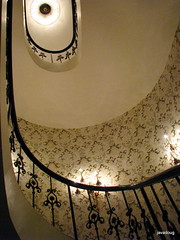
Gil Shaham performed the solo for both of these at Heinz Hall this evening:
Wolfgang Amadeus Mozart: Violin Concerto No. 2
Franz Joseph Haydn: Violin Concerto No. 2
His movements were graceful and deliberate.
The violin he played had the most magnificent tone.
When the movement called for two strings to be played simultaneously, the sound came forth with striking clarity, and immediately grabbed my attention. Then he would return to the pure tones of the composition and his marvelous style. His smile was brimming -- there is never a doubt when I see that, it's the musician who equally loves the music.
I've heard both of these concertos before; both have marvelous simplicity yet melody and harmony which are catchy and so pleasant to hear. Although my favorite Mozart violin concerto is number 3 - for it's wow factor, I do have to say that number 2 is equally nice, and this performance was invigorating. Mr Shaham and the orchestra (smaller than the full orchestra) played the notes extremely pure, and with the excellent acoustics at Heinz Hall, I could hear and enjoy a distinct clarity. If I closed my eyes it was as if I were right there up on stage.
The Hayden was another concerto I've heard often on CD and radio, and is much better when played live at Heinz Hall. Here is Mr. Shaham playing another Haydn concerto: Haydn Co 1, 1st mov
One of my friends thought it might be odd to play these two smaller limited concertos at Heinz Hall, as if this were a chamber concert, but somehow I believe it worked, it was a good classical introduction to the second half of the program, the larger romantic Mahler Symphony number 4.
As I was listening to both of these concertos, I imagined I could place myself anywhere in the concert hall, and photograph the artists and their instruments on the stage. Since I am an amateur photographer, I enjoy visioning what a possible 'shot' would look like, even if I don't have my camera in hand. The PSO doesn't allow photography of the musicians on the stage, I suspect it is because flash would completely distract warm-ups or the actual performance; and perhaps because they want to maintain a certain decorum, and would prefer that their photographs be professionally produced to be of good quality.
So I sit there, and listen intently to the wonderful music, and I imagine the perspectives I could create, the kinds of lighting I could use for background 'bokeh' a sort of effect you often see in photography. The photos above were taken in the lobby as Mr. Shaham was signing autographs.
I'll post again on the wonderful Mahler Symphony...





